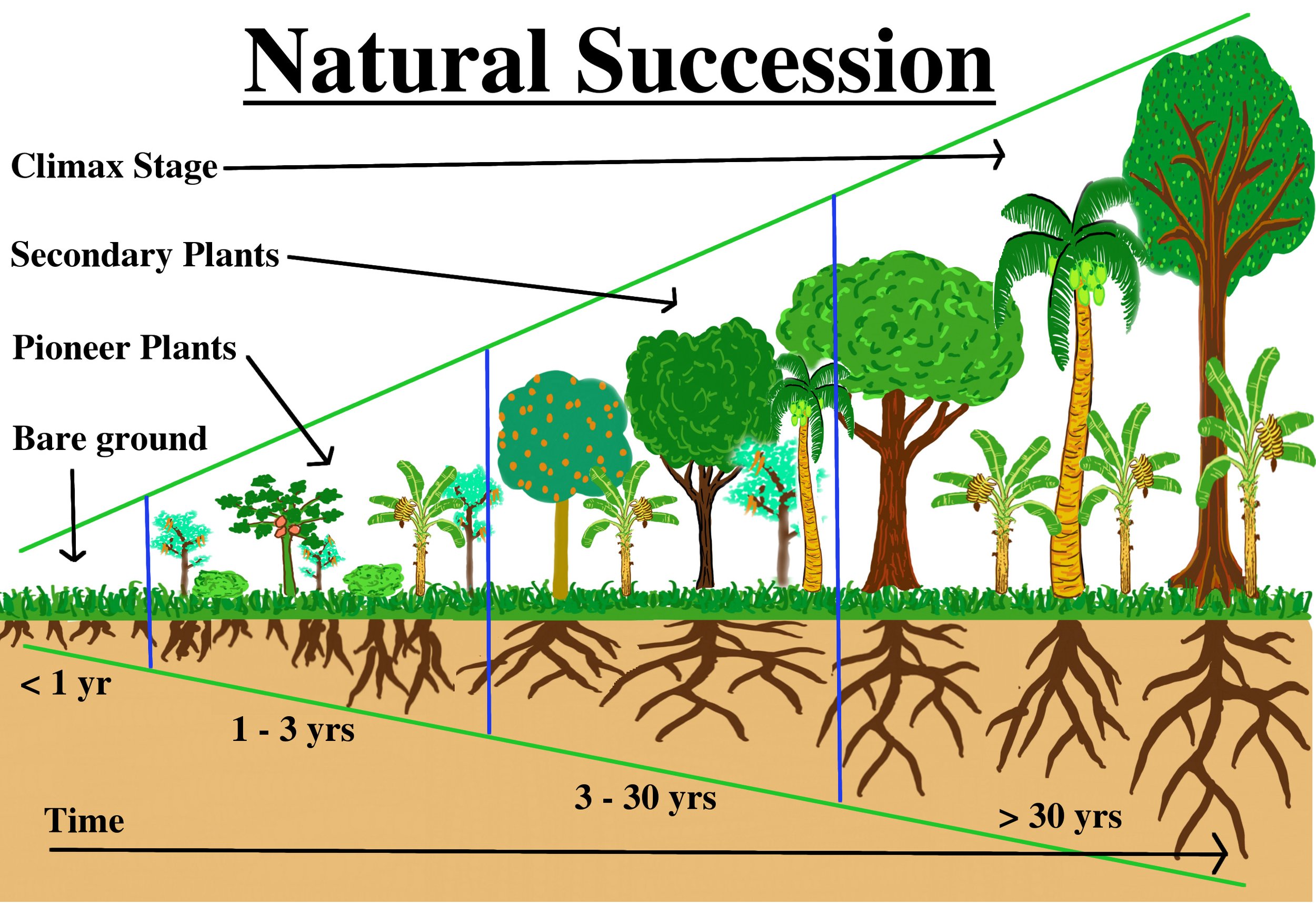What is Syntropic Farming?
By Joshua Wright, apprentice 2022
Syntropy and entropy are two forces at work in this universe. Entropy being the movement of matter and energy towards chaos and simplicity over time. Syntropy being the opposite, of the movements of matter and energy towards higher levels of complexity and order over time. Syntropic farming is tapping into this universal force and leveraging it to produce a product useful to humans, food.
On Earth plants are the drivers of syntropy. Through photosynthesis they accumulate solar energy and make that energy available to other forms of life. Over time this accumulation of energy has led to the ability of our planet to support the order and complexity of life we see today.
To understand how we can use this for food production we need to have an understanding of a natural forest system and how it evolves and accumulates energy.
A forest cycle:
We define a forest cycle as from clearing to clearing.
Starting with a blank slate, "weeds" and grasses colonized bare ground. Slowly energy accumulates supporting shrubs, small trees and eventually a mature forest. Then an old tree dies and falls creating a new clearing.
This is one cycle. This process can take thousands if not millions of years. Then the next cycle begins anew. However this cycle isn't starting from the same point as the cycle before. The system has millennia of accumulated energy stored as organic matter, topsoil and biodiversity. The time taken in cycle two to reach a mature forest is dramatically reduced compared to cycle one.
This is syntropy at work!
When we start a syntropic agroforestry system we start by creating a clearing, kick-starting cycle two.
So what do we plant in this clearing?
When selecting our plants we want to make sure to represent all the different layers in a mature forest. The layers are categorized as Emergent, High, Medium and Low.
Mimicking a forest our emergent layer should occupy 20% of the canopy. Below that our high layer will occupy 40%, Medium 60% and low 80%.
Image by Orchard of Flavours
These layers are directly related to how much sunlight a plant needs to thrive. E.g. Papaya is emergent needing full sun. Most of your familiar fruit trees occupy the high layer, cocoa would be in the medium or low layer along with coffee as they tolerate lots of shade.
Another consideration when deciding what to plant is how quickly a plant will grow.
This takes us to a key idea in syntropic farming.
Maximizing solar energy capture
We don't want to have to wait several years for our fruit trees to be mature to have a closed canopy with maximum solar capture. We want to harvest this energy immediately.
To do this we have to design our syntropic farm not only in space but also in time.
A helpful tool is to further categorize our plants by their life cycle. In syntropic farming these categories are labeled: placenta 1, placenta 2, secondary 1, secondary 2 and climax.
Placenta 1 are fast growing annuals that mature within 6 months. E.g. Radish, arugula (note. these are also part of the emergent layer, not because they are tall trees, obviously, but because of how much sun they need.)
Placenta 2 are slower growing annuals or biannual that are ready to harvest between 6 months and 2 years. E.g. Banana, pineapple, yuca.
Secondary 1 are fast perennials ready between 2-10 years.
Secondary 2 are slow perennials, 10-15 years. E.g. Most fruit trees.
Climax, this category takes over 15 years to mature. E.g. hardwoods and nut trees.
Now I know this is sounding awfully complicated and it is. So let's take a step back and see what this looks like when we start putting it all together.
Image by ECHOcommunity
Understanding our layers and succession planting
We have our clearing, the stage is set.
In a mature forest all the seeds of the different layers are present in the soil together at the same time. When that clearing occurs they all start growing together, some fast, some slow, occupying all the different layers. We will do the same.
Sowing a variety of annuals, perennials, fast and slow growing plants. With good planning what we get is our annuals popping up, harvesting sunlight, shading the soil and providing us with a crop in the first few months. When we harvest those annuals, light and space is opened up for the next succession of plants to come through. There is always a cover of green, growing leaves on our site, photosynthesizing and shading the soil.
After a few years, after the harvest of placenta 2, our fruit trees will be well established saplings. They have been protected from wind and harsh sun, they have had the soil loosened by the roots of all the plants that came before and they are in the perfect position to thrive!
Your Syntropic orchard awaits
Through observing how natural systems work, partnering with nature, humble stewardship and intentional management, humans have the potential to shepherd and accelerate succession. Regenerating eroded landscapes, reversing desertification and growing plants to eat. Let's make our food production systems part of the solution.
Learn More
Join us for one of our yearly workshops about permaculture, farming, plants and more!





